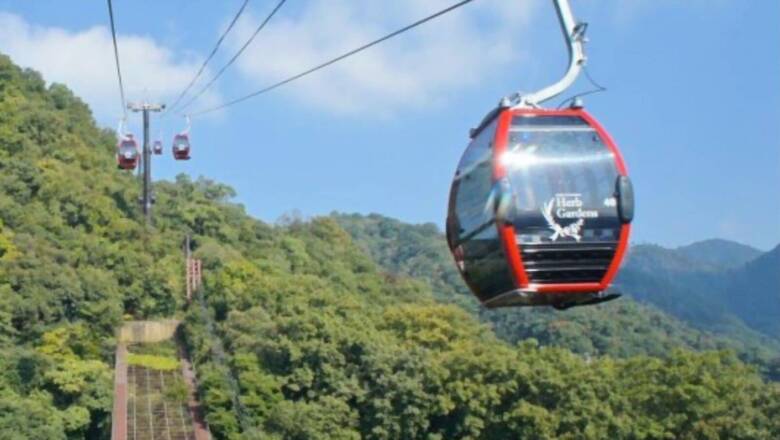
views
Finance minister Nirmala Sitharaman had earlier this year said the National Ropeways Development Programme will be implemented using a public-private partnership (PPP) model with the goal of improving connectivity and increasing tourism.
The construction of eight 60-km ropeway projects will be granted under this programme in 2022-23.
The National Ropeways Development Programme will be implemented as a preferred environment-friendly alternative to conventional highways in tough steep terrain. The goal is to improve commuter connectivity and convenience while also encouraging tourism.
This might also apply to congested urban areas where a traditional mass transit system would be impractical.
Prime Minister Narendra Modi had said on February 15: “For the first time in the country, the ‘Parvatmala scheme’ is being started for areas such as Himachal Pradesh, Uttarakhand, Jammu-Kashmir and the Northeast. This scheme will create a modern system of transportation and connectivity on the mountains.”
“It will also strengthen the border villages of our country, which need to be vibrant, and which is also necessary for the security of the country,” he had said.
In a hilly terrain, developing an efficient transportation network is a major difficulty. Since in these eight places, rail and air transportation networks are limited, and road network development has technical obstacles. In this context, ropeways have evolved as a practical and safe form of transportation.
The Government of India (Allocation of Business) Rules 1961 were revised in February last year, allowing the Ministry of Road Transport and Highways to oversee the development of ropeways and alternative modes of transportation. The action will assist the industry by establishing a regulatory framework.
The programme is currently being implemented in Uttarakhand, Himachal Pradesh, Manipur, Jammu and Kashmir, and other northeastern states.
Ropeway Infrastructure
Ropeways are less expensive to build because they are an aerial mode. As a result, despite having a greater construction cost per kilometre than motorways, ropeway projects are more cost-effective to build than roadways.
This particular transportation process also has the advantage of being able to be built in a straight line across mountainous terrain, allowing for the quickest travel time. Additionally, these projects using 3S (three cables — two for support and one for propulsion) or related technologies can convey 6000-8000 passengers per hour.
In the case of benefits, this mode of transportation will provide mobility to people living in remote places, allowing them to integrate into society. Multiple cars are propelled by a single power plant and drive system on ropeways that save money on both construction and upkeep.
The employment of a single operator for a complete ropeway results in additional labour cost savings.
Here Are The Ropeways In India
Gujarat: Modi inaugurated this Girnar Ropeway on October 24, 2020. The ropeway covers a distance of 2.3 km in under 7.5 minutes. In addition, the Girnar Ropeway offers a spectacular perspective of the lush greenery that surrounds the mountain. Earlier, the only option to visit Girnar Mountain was by climbing 9,000 stairs. Now, the ropeway has given another facility to devotees. It used to take 5-6 hours to travel to the temple; now, it takes only a few minutes. More than 2.13 lakh people have used it in just two and a half months.
Assam: The Guwahati Passenger Ropeway, which connects Guwahati and North Guwahati across the Brahmaputra River, was opened to the public on August 24, 2020. This is India’s longest ‘ropeway over a river’, measuring about 2-km long and stretching across the Brahmaputra. The ropeway, built at the cost of Rs 56 crore, has two cabins, each with a capacity of 30 passengers, and one operator. It is one of India’s most modern and longest Aerial Tramway systems for bridging rivers.
Jammu: The Gulmarg Gondola cable car circuit in Jammu is situated at 2,730 meters in height, covers a distance of 2.5 km. This circuit takes visitors to an astounding height from where visitors can spectacular views of the towering mountains.
Sikkim: Gangtok’s Bi-Cable Zig Back is known for being one of the most durable, stable and standard ropeway engineering marvels. This is situated at 1,676-m height and covers a 1-km distance within just seven minutes.
Rajasthan: Mansapurna Karni Mata Ropeway, located 3 km from Udaipur City Railway Station, is a popular cable car ride that connects Sri Karni Mata Temple at Machhala Hill Top and Deendayal Upadhyay Park in Udaipur. It is one of the most popular tourist attractions in Udaipur and the ride takes only a few minutes.
Uttarakhand: Aerial Ropeway transports people from Mallital to the Snow View Point, one of the most popular sites to visit in Nainital, with hundreds of visitors flying in each day. This three-minute trip is nothing short of a dream since it provides the best bird’s-eye view of Nainital City and Naini Lake. It is situated at a height of 2,270 m, and takes 151.7 seconds to reach there.
Future Ropeway Projects Under National Ropeway Development Programme
A Memorandum of Understanding (MOU) has been signed with the Uttarakhand Tourism Development Board (UTDB), which is responsible for the development of ropeways in the state. In the beginning, seven projects in Uttarakhand were identified. Kedarnath and Hemkund Sahib DPR Ropeway construction are underway, and NIT has been invited to participate.
It was announced that Gap Funding for Passenger Ropeway system from Pelling to Sanga-Choeling in West-Sikkim. The Prime Minister’s Development Initiative for North-East “PM-DevINE” would be implemented through the North-Eastern Council, according to the Finance Minister. The new initiative would be given an initial budget of Rs 1,500 crore. The estimated cost of this project is Rs 64 crore.
Separately, PM-DevINE, with a budget of Rs 58 crore, would fund infrastructure and social development projects in the spirit of PM GatiShakti. These initiatives (West Sikkim and South Sikkim) will enable youth and women to engage in livelihood activities, addressing shortages in many sectors, according to the minister. The ropeway project is one of the first projects to be recognised as part of the scheme.
Upcoming projects also include ropeway at Ibudhou Marjing, Imphal East. On January 4 this year, PM Modi paid a visit to the states of Manipur and Tripura. He laid the foundation stone for 22 development projects in Imphal, totalling over Rs 4,800 crore, including a ropeway project at Ibudhou Marjing, Imphal East.
There is another project, which will take place in Hemkund Sahib. Last year, on December 13, Prime Minister Narendra Modi paid a visit to Kashi Vishwanath Dham in Varanasi, Uttar Pradesh. While the Kartarpur Sahib Corridor has been completed, the PM announced that plans are in the works to build a ropeway for quick and easy access to Hemkund Sahib.
According to authorities, Himachal Pradesh, Manipur, Arunachal Pradesh, Sikkim, Maharashtra, and Jammu and Kashmir have also submitted proposals to establish ropeways.
Read all the Latest News India and Breaking News here




















Comments
0 comment